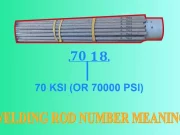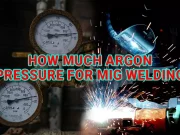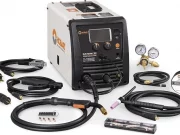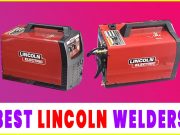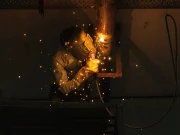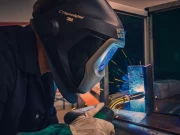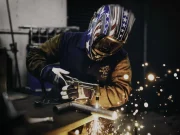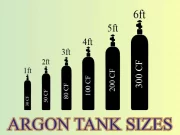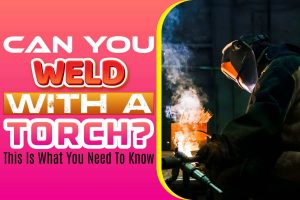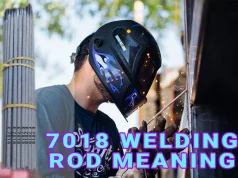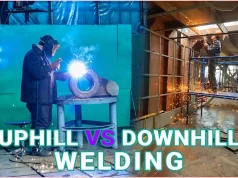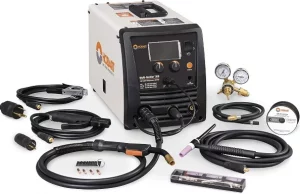Welding is a fabrication method that involves the use of heat to fuse materials. Welding is most commonly associated with metals and thermoplastics.
A welding torch is a mechanical device that melts pieces of metal. It does this by fusing an open flame with gas and oxygen.
Welding is an age-long mechanical practice for joining different metals. In earlier times, welding involved pounding pieces of metal together under heat until they fuse.
So, if a torch can melt pieces of metal, can you weld with a torch?
Can you weld with a torch?
Yes, you can weld with a torch. Torch welding has been a widely used method. Before the advent of electricity, it was a commonly utilized method in agricultural and rural communities.
The torch welding machine is versatile and may be used for many tasks, from small gadgets to enormous structures.
You can heat and cut different types of metals using torch welding equipment. It also has the strength to work with steel.
Continue reading to learn more about the torch welding equipment.
Torch Welding Equipment
A basic torch set consists of two high-pressure cylinders – oxygen and acetylene cylinders – filled with various gases.
The cylinders are connected to the torch via two pressure control regulators. The regulators supply oxygen and acetylene through a dual-hose system.
To achieve the required outcome, you can connect many types of tips to the torch nozzle. To cut, weld, or mold metal, you can attach the handle to a cutting head, welding tip, or heating attachment.
If you’re cutting metal with the torch, you’ll need an extra cutting tip that attaches to the cutting head’s end. This extra tip helps manage the flame’s thickness, making it easier to cut even thicker metals.
Most times, torch welding equipment containing oxygen and acetylene reaches the same working temperature of 5,620 degrees.
Some individuals erroneously believe that a large gas tank will produce higher temperatures, and a smaller gas tank will produce lower temperatures.
The size of the gas cylinders does not affect the temperature of the flame. The size only has an impact on how long the flame lasts.
Before starting work on a project, make sure your cylinders are filled with gas to prevent you from running out of gas while on the job.
When your flame doesn’t have a blue color, you do not have enough oxygen. Make the necessary adjustments to the oxygen knob.
The presence of a fuel-rich flame will be noticeable since it will have a yellow color. If you are using it for the first time, practice on different things to have a sense of moving the torch at different angles.
Weld-on scrap metal pieces that are near to the same size as the stuff you’ll eventually weld.
How To Weld With Torch
Once your workspace is ready, perform a torch weld by following the steps below:
- Separately purge the oxygen and acetylene gas lines.
- Turn the fuel gas valve on by only half a turn.
- Tilt the lighter to catch some fuel in the spark cup, then slowly light the torch with the striker.
- Increase the acetylene flow into the torch until the flame seems to leave the tip of the torch and no smoke is emerging from the flame.
- Reduce the pressure until the flame returns to the gun’s tip.
- Open the oxygen valve and adjust the settings until the flame is neutral.
- Adjust the flame by depressing the oxygen lever and making any required adjustments.
- Clean the metal that will be weld together first. Wipe away any surface-level filth and debris. Scrub away any harder-to-remove particles with an abrasive cloth.
Wipe down the metal with acetone or another cleaning chemical to remove any oils or grease.
- Prepare the fuel and oxygen in the torch tank until a bright blue flame appears on the blowtorch.
The blue coloration suggests a flame that is hot enough to braze metal properly. The hottest area of a welding torch is the tip of the blue component of the flame.
- Make focused heat on the metal by moving the flame in a circular motion. To limit the amount of heat-affected areas surrounding the weld, keep the flame close to the weld spot.
- Move the molten filler metal along the weld joint with the blowtorch. Do this until the two metal pieces are effectively together.
Gasses Used For Torch Welding
Welding gas can be unit gas, binary or ternary mixed gas, or a combination of the two. Welding gas helps improve weld quality, minimize the width of the heating zone of the weld, and prevent oxidation of the material.
The choice of welding gas mixtures depends on the welding specifications needed. Gas welding (that is, welding with a flame) employs oxygen and fuel gas.
To manage the chemistry of the flame, the type of fuel gas used for welding must be extremely specialized. The reason is that it must be able to burn hot and at various oxygen/fuel ratios.
Acetylene has traditionally been the most popular because it burns hot in a fuel-rich combination, leaving little or no surplus oxygen to contaminate the weld.
However, because acetylene is a hazardous fuel that is difficult to make, transport, and store, substitutes such as propane and MAPP gas are becoming more popular.
Propane is a more practical and cost-effective fuel for brazing, cutting, and general heating, but it is not appropriate for fusion welding.
Because propane torches employ a mixture of propane gas and oxygen, they are classified as air-fuel torches. When lighted, this mixture generates a clean-burning flame for heating or welding.
If you don’t need to weld often or are worried about your environment, propane torches can be a good option because they are inexpensive, clean-burning, and recyclable.
When working on a welding project, safety should always come first. You deal with very volatile gasses. Safety then would include how you handle the equipment and also yourself.
Safety Practices For Welding
When you weld with a torch, there are safety precautions and rules that you should constantly follow. These rules will help you avoid an accident and increase the quality of your work.
Torch welding produces a large flame, which can be dangerous. When you cut metal, you’ll also get a lot of splatters. Make sure you’re wearing protective gear.
Your protective gear should include long-sleeve gloves, long pants and shirts, welding shoes, and plenty of eyes and facial protection. Also, ensure you are working in an open area with no flammable materials nearby that could cause a fire.
Check the following items before lighting the torch.
- Ensure that the regulator pressure adjustment screws are fully backed out.
- Make sure the torch valves are completely closed.
- Keep your distance from the regulator’s front.
- Slowly open the cylinder valves for oxygen and acetylene.
- To tip the pressure settings, carefully adjust the regulator screws.
- Open and close the torch valves independently to check them, then fine-tune the pressure settings on the regulators.
- Before lighting the flame, depress the cutting lever and adjust the pressure if you’re cutting metal.
Protective Gear For Torch Welding
Personal Protective Equipment:
Personal protection equipment (PPE) is always a necessity in the workplace. It is one of the most basic welding needs.
Few people weld without safety equipment, and those who refuse do not remain long in the welding industry or life.
Welding boots:
Welding boots are comparable to work boots, but they can safely withstand electrical currents while also enduring the heat and impact of a welding shop.
Metal landing on your foot is normal, so it protects your feet from harm and keeps your laces from getting scorched.
Welding helmets:
Welding helmets are essential for protecting your face and eyes from the hazardous heat and UV rays released during the welding process.
While most welders wear helmets while running beads, they don’t always flip them down when tacking.
When you’re constantly exposed, this can cause burns in the near term and have a serious long-term effect.
Gloves:
Gloves allow you to touch hot, freshly welded products while also preventing splatter from burning holes in your hands. Gloves also shield your skin from harmful ultraviolet rays. These rays do not cause pain during the welding process, but they do produce terrible burns overnight, as well as long-term skin diseases. These rays can also accelerate aging and increase the risk of cancer.
Respirators:
Respirators are devices that you wear over your mouth to allow you to breathe clean air.
They either use filters to remove hazardous gases and compounds from the air or bring clean air from another location for you to breathe. Although they do not fit in all welding helmets, a few do.
Conclusion
Welding is a fabrication method that involves the use of heat to fuse materials.
You can weld with a torch. Torch welding has been a widely used method. Before the advent of electricity, it was a commonly utilized method in agricultural and rural communities.
A welding torch is a mechanical device that melts pieces of metal. It does this by fusing an open flame with gas and oxygen.
A basic torch set consists of two high-pressure cylinders, oxygen and acetylene cylinders connected to the torch via two pressure control regulators. The regulators supply oxygen and acetylene through a dual-hose system.




